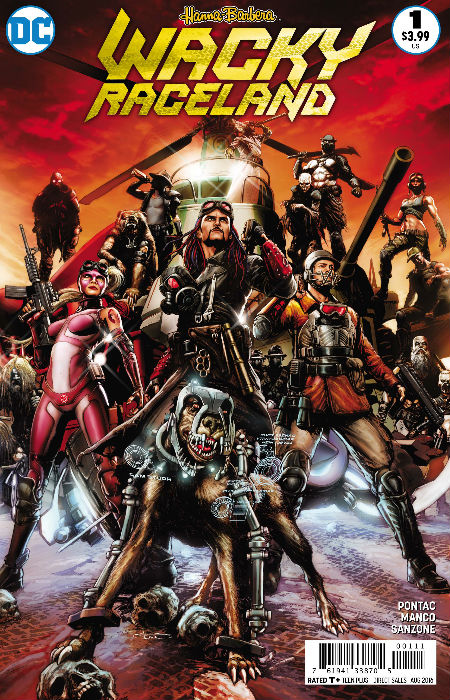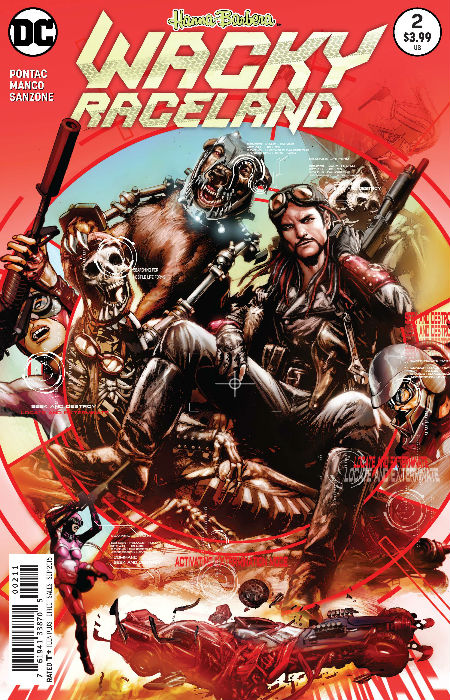
The apocalypse is upon us once again, bringing it with a radically different take, not to mention three-headed mutants, on Hanna-Barbera’s classic late ’60s road race, Wacky Races.
The somewhat still-playful title aside, this is a considerably darker take on the cartoon series which featured 11 cars, 23 characters (and some rather bold unsportsmanlike behaviour), all of whom were racing for some ill-defined reason which spurred them on to risk everything to get to the finish line first.
There’s no such mystery in Wacky Raceland, which takes place on a ruined Earth, a scorched radioactive wasteland beset by the aforementioned zombie-esque mutants with a taste for human flesh, nanite dust storms that strip you bare faster than a swarm of piranhas and an environment so bespoiled that no amount of weekend working bees by the neighbours will restore it.
Into this accursed world, a hidden controlling entity called The Announcer, calls all the shots, plucking the 11 cars, all of whom are now AI-sentient, and their drivers and passengers from situations where death was certain and solutions perilously thin on the ground.
That’s not to say that being “saved” by The Announcer, who is rumoured to be a lot of things including a twisted murderous Führer of some kind, is any kind of blessing; not in the long-term at least.
Yes you are saved from certain death and your car becomes its own class of souped-up self-aware being but your survival beyond that rests on winning a series of races and gaining entry to Utopia, a blissful world which is the last bastion of humanity in a world long ago left in ruins at its hands.
So the racers, all of whom retain their names if not their looks, which now have a decidedly Mad Max-ian edge, and their ruthlessness to win – if you recall, everyone went to a great deal of trouble to win in the Wacky Races with some fairly cutthroat tactics employed; it’s not as squeaky clean and cute as you remember – and their quirky names.
Dick Dastardly and Muttley naturally are front and centre, still unable to win a race (most of the time) to save themselves (literally), with Penelope Pitstop, a ruggedly though pink-accented feminist with no need for anyone and a huge amount of bioneural augmentation, often racing ahead and holding her own in a bar fight thank you very much.
We also encounter everyone from a transgender Sergeant Blast still with Private Meekly, a mutant-lloking Ant Hill Mob and a very angry Ant Hill Mob with everyone present and accounted for, and liable to be consumed by Africanized Battlejackets on the whim of The Announcer.
It’s the apocalypse with race cars and aggrieved survivors and no one is looking to make friends or influence people; kill them perhaps but not befriend them with every phrase uttered either a defiant declaration of warlike aggression or a rallying cry to violence.

Though Wacky Raceland may sound a million miles form its goofy predecessor of almost 50 years before, it retains quite a bit of the tropes and narrative momentum that made the show a whole lot of (repetitive) fun to watch.
The characters are, of course, all present and accounted for and still raring to win; granted they’re are now considerably more apt to annihilate rather than waylay their competitors since life itself is at stake, but the spirit of competition is much the same.
So too is Dick Dastardly willingness to do whatever it takes to win and his failure to make good on that intent.
While his do-or-die, ethically-free motivation to win at all costs which powered him throughthe original series is now that of all his competitors, rendering him less clearly marked out as a class-A baddy, he is an existential mess, saddled with the terrible guilt of watching his wife and son die while he lived safe and sound inside the War Memorial Opera House in San Francisco.
Penelope Pitstop too still have some of her girlish charm but that’s mostly employed as a way of disarming her enemies who assume a women couldn’t possibly pose any kind of threat.
Think again everyone – Pitstop wants to get to Utopia as badly as anyone and will do whatever it takes to get there.
The freeze frames that marked the cartoon series, which provided you with a chance to see who was placed where in the race, are given a loving nod of the head too, with the lavish artistic renderings by Leonardo Manco matched by writer Ken Pontac cheeky, ballsy commentary.
The series is marked by rather frequent, jagged back and forth action between the past, present and future, each instalment told with the same sort of breathless, messy excitement that marks the comics as a whole.
This is not your childhood cartoon creations reborn so much as obliterated by a nuclear blast and remade from the ground-up, disillusioned, Darwinian to the core and ruthless to the end, and despite scepticism that such a radical departure couldn’t possibly work in light of the fey campness of the original, it does and spectacularly so.
You realise as you’re reading it that if you strip away all the hilarious commentary by, yes an announcer, and the comic set pieces that dotted each episode, Wacky Races and Wacky Raceland share a sizeable amount of storytelling DNA and attitude.
It’s still all about winning the race, although in this new darker, nastier, more brutal though still camp as hell iteration, the stakes are way higher and losing is not something you want to Muttley-snigger about lest you never rise again.